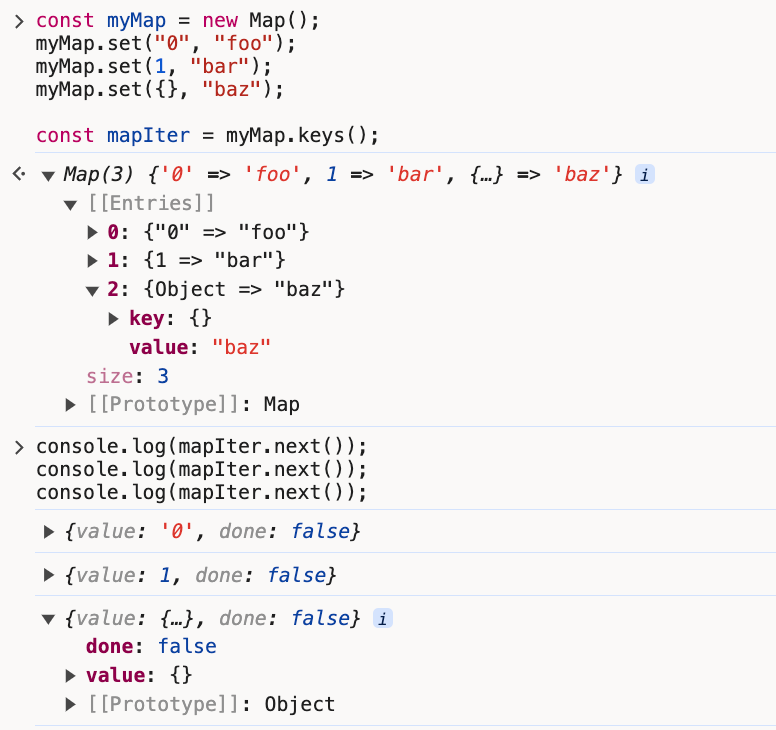什么是 LRU
LRU 是一种缓存淘汰算法,用于管理缓存中的数据。算法思路是保留最近使用过的数据,淘汰最久未被使用的数据
需要实现的功能如下:
- 设置缓存大小:初始化容量,当容量达到上线时,需要淘汰数据
- 设置数据: 将数据写入缓存。需要判断缓存容量,并将当前的值设置为最新使用的
- 获取数据: 从缓存中读取数据,并将当前的值设置为最新使用的
- 淘汰数据: 缓存容量达到上线时,需要删除最久未使用的数据
代码逻辑如下:
java
LRUCache lRUCache = new LRUCache(2);
lRUCache.put(1, 1); // 缓存是 {1=1}
lRUCache.put(2, 2); // 缓存是 {1=1, 2=2}
lRUCache.get(1); // 返回 1
lRUCache.put(3, 3); // 该操作会使得关键字 2 作废,缓存是 {1=1, 3=3}
lRUCache.get(2); // 返回 -1 (未找到)
lRUCache.put(4, 4); // 该操作会使得关键字 1 作废,缓存是 {4=4, 3=3}
lRUCache.get(1); // 返回 -1 (未找到)
lRUCache.get(3); // 返回 3
lRUCache.get(4); // 返回 41
2
3
4
5
6
7
8
9
10
2
3
4
5
6
7
8
9
10
JavaScript 中的 Map
Map.prototype.keys() 会返回一个 map 的 keys 对象的迭代器
js
const myMap = new Map();
myMap.set('0', 'foo');
myMap.set(1, 'bar');
myMap.set({}, 'baz');
const mapIter = myMap.keys();
console.log(mapIter);
console.log(mapIter.next());
console.log(mapIter.next());
console.log(mapIter.next());1
2
3
4
5
6
7
8
9
10
11
12
2
3
4
5
6
7
8
9
10
11
12

可以看到,map keys 迭代器返回的顺序,就是设置 key 的数据。越早设置,在迭代器中的位置越靠前
基于此,可以使用 Map 这种数据结构实现 LRU
代码实现
ts
/**
* Least Recently Used
*/
class LRUCache {
capacity: number;
cache: Map<any, any>;
constructor(capacity: number) {
this.capacity = capacity || 5;
this.cache = new Map();
}
/**
* 向缓存中设置值
* 1. 如果缓存中存在 key, 覆盖对应的值,将本次的值设为 LRU
* 2. 如果缓存中不存在 key
* 2.1 缓存未满,直接设置值,并将本次的值设置为 LRU
* 2.2 缓存已满,删除最久未被使用的值; 设置本次的值为 LRU
* @param {*} key
* @param {*} value
*/
put(key: any, value: any) {
if (this.cache.get(key)) {
this.cache.set(key, value);
this.refresh(key);
return null;
}
if (this.cache.size >= this.capacity) {
// map.keys 返回的顺序是设置的顺序,越早设置的越靠前
this.cache.delete(this.cache.keys().next().value);
}
this.cache.set(key, value);
return null;
}
/**
*
* 获取缓存中对应键的值
* 如果存在,返回对应的值,并刷新为 "LRU"
* 如果不存在,返回 null
* @param {*} index
*/
get(key: any) {
if (!this.cache.has(key)) {
return -1;
}
// 刷新为 LRU
this.refresh(key);
return this.cache.get(key);
}
private refresh(key: any) {
const value = this.cache.get(key);
this.cache.delete(key);
this.cache.set(key, value);
}
}
const cache = new LRUCache(2);
console.log(cache.put(1, 1)); // 返回 null 此时cache为【1】
console.log(cache.put(2, 2)); // 返回 null 此时cache为【2,1】
console.log(cache.get(1)); // 返回 1 此时cache为【1,2】,因为使用了1,1变成“新鲜的”
console.log(cache.put(3, 3)); // 返回 null 此时cache为【3,1】,超过容量了,把“老油条”2淘汰
console.log(cache.get(2)); // 返回 -1 此时cache为【3,1】
console.log(cache.put(4, 4)); // 返回 null 此时cache为【4,3】,超过容量了,把“老油条”1淘汰
console.log(cache.get(1)); // 返回 -1 此时cache为【4,3】
console.log(cache.get(3)); // 返回 3 此时cache为【3,4】
console.log(cache.get(4)); // 返回 4 此时cache为【4,3】1
2
3
4
5
6
7
8
9
10
11
12
13
14
15
16
17
18
19
20
21
22
23
24
25
26
27
28
29
30
31
32
33
34
35
36
37
38
39
40
41
42
43
44
45
46
47
48
49
50
51
52
53
54
55
56
57
58
59
60
61
62
63
64
65
66
67
68
69
70
71
2
3
4
5
6
7
8
9
10
11
12
13
14
15
16
17
18
19
20
21
22
23
24
25
26
27
28
29
30
31
32
33
34
35
36
37
38
39
40
41
42
43
44
45
46
47
48
49
50
51
52
53
54
55
56
57
58
59
60
61
62
63
64
65
66
67
68
69
70
71